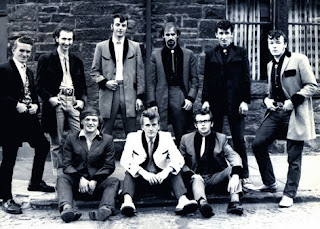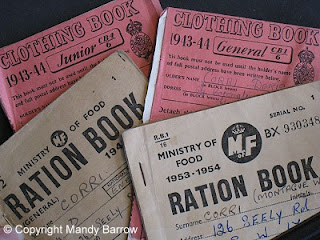Wednesday, 2 January 2013
Fashion Revolution
As well as all these brilliant trends, another fashion revolution was happening...inside the textile mill.
Synthetic materials were being created such as Acrillian, Orlon and Poplin were developed.
These materials, along with nylon (1938) took over from wool and cotton.
They were cheaper to produce, easier to dry, they didn't crease- the list could go on!
Pop Art
Society rejected the wartime values of quality and permanence. 'Pop Art' emerged.
Pop artists started to embrace commercial and the American Culture.
Every teenager began to follow fashion cults.
-Jukebox Culture
-Marylin Monroe
-Elvis Presley
-Marlon Brando
-Jayne Mansfield
-Jane Russell
Youths
The youths of South London, were inspired by the 'dandie style' and adopted their clothing to create the aggressive yet stylish ''teddy boy''.
These jackets were extremely colourful, and the trousers were so narrow they called them 'Drainpipes.'
Thick sole 'Brothel Creepers' and boot lace ties were also popular. Men greased back their hair with Bryll cream (long quiff at the front and D.A at the back)
Menswear
Throughout the war years mens fashions had hardly changed. But during the 50s menswear steadily moved its way into the limelight.
It was suddenly fashionable to be fashionable.
After the war years, attitudes dramatically changed. Following the trend of nostalgia, brought on by Dior's New Look, Men adopted the style of Edwardian attire.
The business men of London wear the first to wear the look. Men wore bowler hats, long line single breasted jackets and narrow pinstripe trousers.
Mary Quant
In 1955, Mary Quant adopted the same silhouette. She opened up her first store in London called ''bazaar''.
The Sack Dress
As the New Look design reached its all time high, people started to turn the idea on its head. They liked the idea of a dress being less restricted around the waist. Balenciaga created the Sack Dress.
Next Dior rivaled with the Tunic dress. Which was similar.
Blue Jeans
Blue Jeans were originally created for workwear, but during the 1950s it was the uniform of the ''teenagers''.
Nowadays we can get jeans in almost any colour, but back in the 1950s only blue was available because of the dye they use and the way they make them.
Audery Hepburn
Audrey Hepburn was a British actress and humanitarian. She was a fashion icon, her looks and style were widely recreated by many people.
The floral day dress
Dior's famous look was widely copied and mass produced by many companies. It was one of the most recognizable fashions of the 50s.
After the war, men returned to the workforce, and women were encouraged to return to their traditions as a housewife.
Many women started to groom themselves perfectly. They wore eye make up, gloves, earrings and lipstick.
The stiletto was the footwear equivalent to Dior's New Look.
Resort Wear
Because the war had ended, people had more time on their hands and the resort industry was booming. So people took the opportunity to buy a new wardrobe full of separates.
Beach wear styles were big in America and Europe.
St Tropez held annual shows to show off the new beach wear collections.
In 1947 the first ever bikini was created.
1950s- The Teenager had Arrived...
After the war ended, youth and optimism was at the forefront of society. The changing face of fashion revolutionized the industry. Which meant there were bigger businesses. Also, fashion was embraced by more people than ever before.
Teenagers were able to get their own jobs, they had more freedom and they were allowed to leave home at a earlier age.
Christian Dior
His rapid success meant that his business grew.
In 1948, he named a new collection 'Envol' (means Flight) which featured skirts worn with scooped back jackets and stand up collars.
Also, he was famous for the Princess line, Coolie hats and Straight skirts.
1947
In 1947 WWII ended. Paris once again became the mecca for fashion design. Paris collections of 1947 heralded what came to be called ''The Golden Age of Couture''
In the spring of 1947, Christian Dior revived his design called 'New Look'.
This look was very feminine, and it showed of the natural curves of a women.
Zoot Suits
Zoot Suits were worn by musicians of black origin. They were high waisted trousers which has wide legs and lapels. This look heavily influenced menswear, it showed people that they wanted to be different.
American Style
With many American troops being mobilized, American influences spread rapidly. Coca Cola and Chewing gum were much sought after. American soldiers impressed British girls with gifts of nylon stockings.
American Dance crazes spread.
-Boogie Woogie
-Big Band
-Swing
The fall of Paris
After the fall of Paris in 1940, French women adopted a style which became known as the Paris Hat. The style was said to laugh in the face of the Nazi Occupation. The huge elaborate hats were worn with dignity.
Maps of France were printed on scarves which helped soldiers who had just landed find their way round. Also handbags were made with false bottoms to hide resistance leaflets.
Maps of France were printed on scarves which helped soldiers who had just landed find their way round. Also handbags were made with false bottoms to hide resistance leaflets.
Fashion during the war
The romantic, full skirted sillouette which was popular in the late 30s was put on hold.
War time meant publications such as Vogue, adopted slogans such as ''Dig for Victory''. Women were required to join the work force while their husbands went to war. Nylon stocking were rationed and women started to wear trousers.
During the war most women undertook traditionally masculine activities which imposed a suspension of social conventions regarding dress. 80,000 women undertook predominantly male roles, serving as cooks, drivers and postal storage workers in The Auxiliary Territorial Service. Previous to 1938 they wore a khaki uniform of a shirt, tie, cap, jacket and shirt. However, with the introduction of clothing rationing in June 1941, government regulations ruled practical trousers and overalls, causing fashion to take a back seat.
In response to the shortage of fabric a range of utility clothing was introduced, which used the minimum amount of cloth and was devoid of embroidery. Men’s and boy’s jackets only had three buttons and two pockets and trousers had no turn-ups. Women’s and girl’s dresses had no pleats, elastic waist bands or fancy belts. Utility shoes had a heel which was less than 2 inches.
Silk was banned from civillian use. It was used for parachutes. American soldiers became a source for nylon stockings.
The war encouraged people to reuse their old dresses/trousers etc by sewing up any holes or snags. This was called make-do and mend.
Hairstyles were the 1st vestige of glamour that women hung to, they grew it long, curled it and bound it up in turbans.
1939
Storm clouds of war were gathering over Europe. The glory of Paris and London showed the last fashion collections of the decade. The fashion industry ground to a halt.
Clothes Rationing
To make the British weak, the Germans tried to cut off supplies of food and other goods. German submarines attacked many of the ships that brought food to Britain. This meant that food, fabric and other things were in such short supply. So the government issued books called ''ration books'' so everyone got a fair share of food, clothes etc.
Everyone had to 'make do and mend'.
Fancy Dress
During this time period, there was an element of fancy dress. Couturiers were inspired by historical periods and many countries and cultures.
By the end of the decade, the fashion was so varied. People became confused on what was fashionable and what was not. Many fashions were so extravagant.
This could have been because of the chaos of a world about to plunge into World War II.
Subscribe to:
Posts (Atom)






























